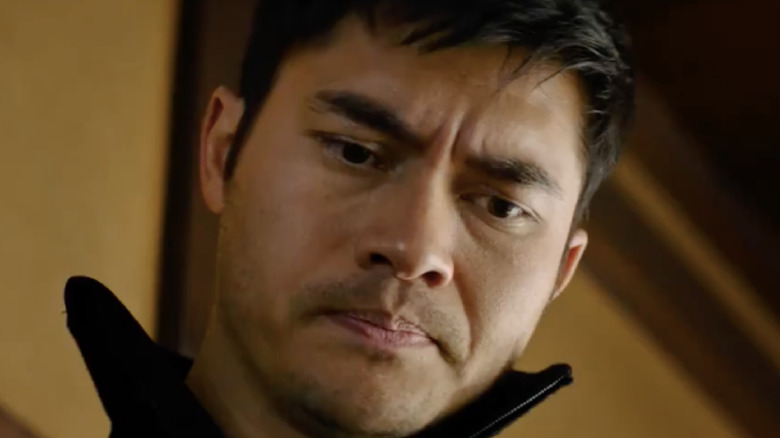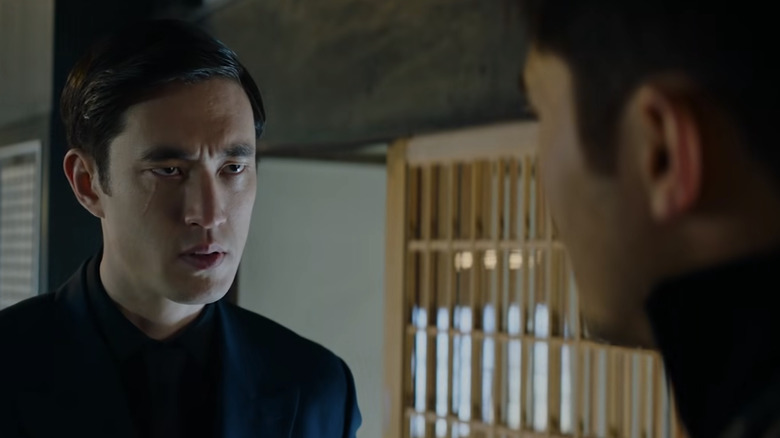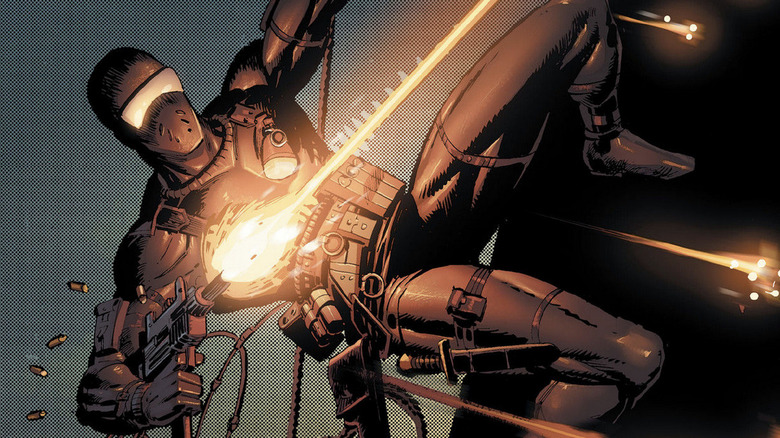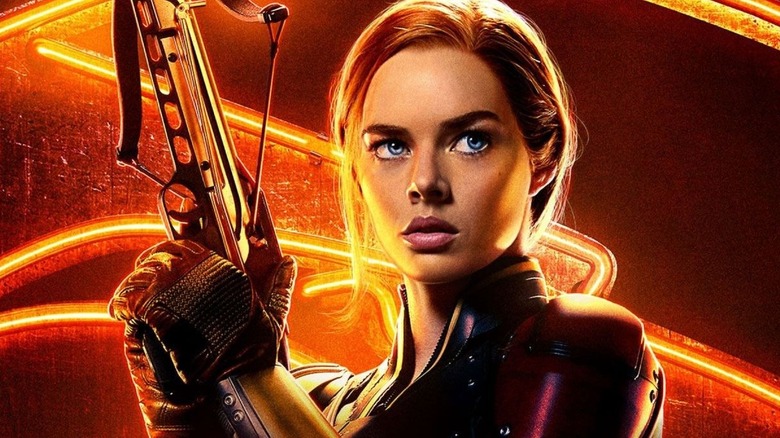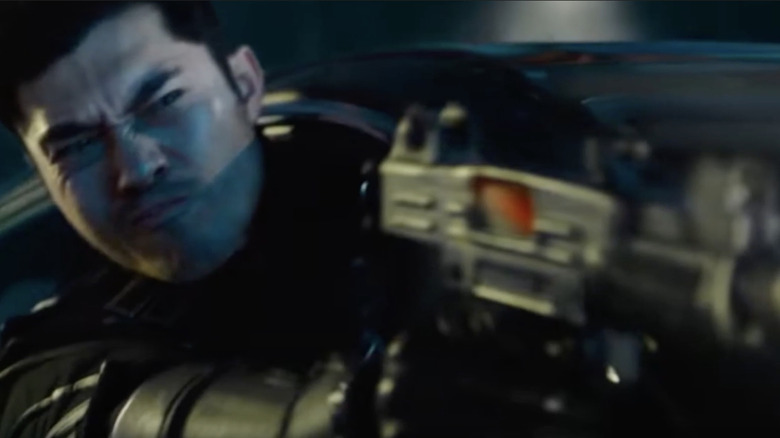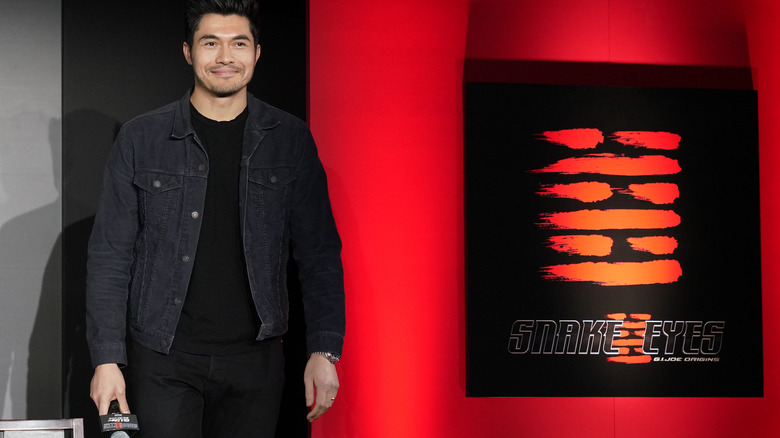Small Details You Missed In Snake Eyes
The three words appended to the title of the "Snake Eyes" movie are intended to tell you the purpose of the film — this is a "G.I. Joe Origins" tale, after all. But beyond the word "origins," it reminds viewers there is a nearly 60-year-long legacy behind the Henry Golding film, one that began with a Manhattan inventor shopping around generic-looking military action figures in 1963, and now stretches all the way to a blockbuster film about the rise of two ninjas.
The decades in between have yielded countless comic books, cartoons, movies and other media, laying out the blueprint to a vast pop culture universe beloved by many. From "the Kung-Fu Grip" to Cobra Commander, from "There's No Place Like Springfield" to Sgt. Slaughter, there are certain touchstones of "G.I. Joe" that immediately bring a nostalgic smile to multiple generations. It's no surprise, then that "Snake Eyes" is filled with Easter eggs, overt name droppings, and forward-thinking world-building that will soar over the heads of some moviegoers and delight others.
With that in mind, and with heavy spoilers to follow, here's a breakdown of the small details in "Snake Eyes" that you may have missed.
Copyright infringement
Early in the film, Snake Eyes (Golding) finds himself befriending Tommy (Andrew Koji, "Warrior") while working on the docks. When Tommy is outed as an interloper by the yakuza, Snake Eyes is ordered to execute him as a sign of loyalty — but refuses to do it. This results in a massive battle, with the two newfound friends taking on waves of sword-wielding warriors. The duo escape, but Tommy emerges with a fresh scar on his right cheek.
This is a reference to the very earliest days of "G.I. Joe," after Manhattan-based inventor/licensing agent Stanley Winston came up with the idea of making military-themed dolls for boys, then sold it to Hasbro for $100,000, promising "You will make a fortune with these."
As the toys went to market in 1964, Hasbro realized they had a hit. They also quickly realized that the somewhat generic-looking faces of the soldiers made them very easy to copy, and cheap knockoffs began chipping away at potential profits. As a result, Hasbro came up with an idea: introduce certain elements of the "G.I. Joe" toys that could be copyrighted. These included giving the 12-inch figures a trademark on their right buttock, the placement of the right thumbnail on the underside of the left thumb (unintentional at first, but maintained for copyright reasons) and putting a scar on their right cheek.
Now, whether Andrew Koji and Henry Golding took the time and effort to brand the words "Copyright 1964 by Hasbro, patent pending" on their right butt-cheek is anybody's guess (perhaps to be revealed someday in an awkward deleted scene), but as sharp-eyed viewers will notice, Tommy does have the scar — which would also become a signature for Cobra Crimson Guards leader Tomax and Xamot in the "Real American Hero" toy line.
Silent Interlude
If you enjoy "Snake Eyes," you need to do yourself a favor after you leave the theater and take a moment to track down — or rediscover — one of the greatest comic books of the "G.I. Joe" franchise, and perhaps in the entire history of the medium. It's called "Silent Interlude," and was released in 1984 as "G.I. Joe" #21.
Until that point, Snake Eyes had been presented almost entirely as an enigma in black — silent, masked, the Joe that was called in to unwinnable situations and somehow managed to come back every time. "Silent Interlude" elevated the series from "toy comic book" to legitimate art form by telling a spinoff tale that had Snake Eyes sneaking into the Cobra castle to rescue Scarlett under cover of darkness.
The entire issue was presented without a single speech bubble, sound effect, or caption — perfect for Snake Eyes' silent, stealthy esthetic. It also introduced Storm Shadow, a Cobra counterbalance to the man in black. After the two engaged in battle and Scarlett was saved, the comic's final panels revealed an earth-shattering secret that to G.I. Joe fans was the comic book equivalent of "Luke, I am your father": Snake Eyes has a red tattoo on his forearm, identical to Storm Shadow's.
Although the "Silent Interlude" plotline is perhaps shelved for a future movie, this "Snake Eyes" film takes much of its world-building from those moments and that reveal. The legendary Larry Hama, a Marvel Comics writer and editor who wrote the licensed "G.I. Joe: A Real American Hero" comics (as well as the "file cards" on the back of each figure, laying out their colorful, official file stories), devised the Clan Arashikage connection, as well as the signature white-and-black imagery that marks their battles — flipped so that the "villain" is the one in white.
At its 1985 peak, the G.I. Joe comic became Marvel's number one subscription, and Hama was receiving over 1,000 letters a week — responding to as many as he could with hand-written notes. In 2009, comic book artist/historian Scott McCloud recalled the issue as: "a kind of watershed moment for cartoonists of [that] generation" and added, "Everyone remembers it. All these things came out of it."
To this day, rumors persist that "Silent Interlude" has no words because the issue was up against a deadline and had run out of time. But Hama said in a 1986 interview that he conceived it that way from the beginning. "I wanted to see if I could do a story that was a real, complete story — beginning, middle, end, conflict, characterization, action, solid resolution — without balloons or captions or sound effects."
As for the trio at the center of this new movie, Hama explained of their creation: "Storm Shadow ties in with Snake Eyes. They sort of complement each other. There's a sort of triad of intertwining loyalties between Snake Eyes and Storm Shadow and Scarlett. I think the whole factor of actual loyalties as it appears is a very powerful fantasy."
My commander wanted me to share this with you
In a key reveal near the end of the film, Scarlett (Samara Weaving, "Ready or Not") hands Snake Eyes a heavily-redacted file folder, saying: "My commander, General Joe Colton, wanted me to share this with you."
The contents of the folder reveal that Snake Eyes' dearly departed father, who he watched being murdered, was actually a G.I. Joe. And that the man who killed him was working for Cobra at the time.
"Your father was one of us, a Joe," explains Scarlett. "He kept you off the grid to protect you. Your father infiltrated a Cobra cell. The intel he provided saved thousands of lives."
These revelations indicate that there has been an ongoing Joe/Cobra conflict for decades (one that also included the now-deceased Kenta, played by Takehiro Hira), even if folks like Snake Eyes and Storm Shadow are just now entering the story.
It also seems appropriate that the name of Colton is evoked. Sometimes referred to as "the original G.I. Joe," he was portrayed by Bruce Willis in 2013's "G.I. Joe: Retaliation." The character largely didn't exist throughout the franchise's "Real American Hero" heyday in the '80s, when missions were typically led by General Hawk, Lieutenant Falcon, or field leader Flint.
Offered in 1994 as a mail-in figure celebrating the franchise's 30th anniversary, General Colton serves as a tie-in to the toy line's original '60s 12-inch figures, a lifelong Joe who now serves in a high-ranking capacity. If there is to be a "Snake Eyes" sequel, this name drop seems to indicate that Colton will be the person welcoming the ninja into the Joe ranks — and that he's been wanting to do so for some time.
"He left some big shoes to fill, your dad," Scarlett tells Snake Eyes, relaying Colton's message. "It hasn't been easy finding someone to fill them."
Signature weapons
Anybody who recalls saving up their allowance money to buy a "Real American Hero" action figure in the '80s also remembers the weapons that would adorn each figure, as undeniably cool as they were likely to be lost between sofa cushions within a matter of days. Several Joe characters in "Snake Eyes" can be seen wielding these weapons.
During the vehicle chase scene, Snake Eyes sets aside his sword for a moment and instead goes for an uzi, both weapons that came with his original 1985 action figure. In a different scene, Scarlett infiltrates the Clan Arashikage grounds and begins taking down the enemy with a crossbow, a reference to her 1982 original action figure. Later, as she engages a jewel-wielding Kenta and his troops, we see that Scarlett's crossbow can fire repeatedly without being reloaded, which was also the case in the "Real American hero" cartoon show.
Symbolism
Are you sharp-eyed enough to have caught the symbol on the floor tile that was pressed to release the trio of anacondas in the Clan Arashikage pit that housed the third test? Did you notice the pilot wings pin on the Baroness in the post-credits scene? Did you notice the lid on the box of weapons? In each of these instances, and a few others throughout the film, the mythology of G.I. Joe begins creeping into an origin story that — for its first hour — feels like it could be a completely new franchise of its own. But it is right around that 60-minute mark that Tommy reveals himself to be headed down the Storm Shadow path, and viewers get a glimpse at crates of ominous-looking weapons stamped with a red Cobra insignia.
In G.I. Joe folklore, Cobra is a terrorist organization bent on world domination. But they also have a frequent correlation to arms manufacturing and distribution, most often facilitated by James McCullen Destro XXIV (aka "Destro"), a metal-mask-clad Scotsman who has been known to start conflicts just so he can sell weapons to both sides. The Cobra logo on these boxes — as well as the presence of his sometimes-girlfriend the Baroness (Úrsula Corberó, from the "Snatch" TV series) — would seem to indicate that Destro is pulling some strings just off camera. In the post-credits sequence when the Baroness recruits Storm Shadow, the pin on her flight attendant lapel also bears the Cobra logo.
The ominous, Indiana Jones-like snake pit of Clan Arashikage is a key set piece in "Snake Eyes," one that we see multiple times. When he is first lowered into the pit, Henry Golding's Snake Eyes is told to step on a certain floor tile that will reveal the third test in his journey to joining the clan. As you may have noticed, that floor tile contains the symbol for Arashikage — the same one seen on the movie's logo, and first glimpsed 37 years ago in the "Silent Interlude" comic as the red tattoo identifying the link between Snake Eyes and Storm Shadow.
